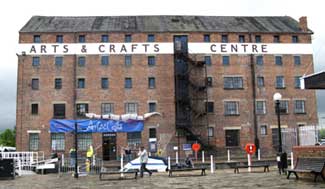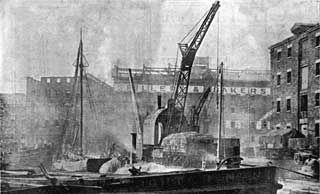 Lock
Warehouse Lock
Warehouse
The warehouse beside
the lock was built in 1834 for Messrs J & C Sturge, the leading
corn merchants of the day. It originally had a ground floor that
was a few feet above the ground, rather widely-spaced cast-iron
columns supporting the floors and correspondingly widely spaced
windows. There were loading doors on each floor in the middle of
each side of the warehouse and at the southern end. Experience evidently
showed that the floors were not supported properly when loaded with
heavy sacks of corn, and additional cast-iron columns were inserted
on each floor in 1877. At the same time, the ground floor was lowered
to ground level and taller cast-iron columns were installed to suit.
The additional columns carry the name of their maker, W Savory &
Son, Gloucester.
Lock Warehouse Occupants
Messrs
J & C Sturge continued using the warehouse for storing imported
corn until the early 1880s, when they ran into financial difficulties.
The building was then occupied by corn merchants Spiller & Co,
later Spillers & Bakers, and they were still there in 1917 when
the roof was destroyed by a fire which spread from the neighbouring
warehouse (see below). After two short-term tenancies, the next
major occupier was Gopsill Brown & Sons, who went on to purchase
the freehold in 1929. Their business was hiring out sacks, some
for use around the docks but many more for use by farmers all over
the surrounding countryside. As well as storing sacks in the warehouse,
Gopsill Brown & Sons needed people working in the building,
cleaning and repairing the sacks, and to suit this change of use
they installed larger widows and built an external fire escape.
Gopsill Brown &
Sons moved to new premises in 1957, and in due course the warehouse
was purchased by builders merchants Jennings & Guildings, later
taken over by Graham Reeves Ltd. Then in 1979, the building was
bought by E J (Eddie) Cook, who adapted the interior to house a
furniture restoration workshop and arcades of small shops selling
antiques and collectables. In July 2009, the Antiques Centre moved to another
building, and in April 2010 the warehouse became an Arts
& Crafts Centre displaying items made locally.
 Pillar Warehouse Pillar Warehouse
The
Pillar Warehouse that formerly stood to the south of the Lock Warehouse
was built in 1835 for Messrs Phillpotts & Baker. It was built
on pillars, with the ground floor open to the quay, in order to
provide a covered area where goods being discharged from a ship
could be stored temporarily when needed.
The
two partners tried to make Gloucester a centre for importing sugar
from Jamaica and Mauritius for distribution throughout the Midlands,
but they soon found they were unable to break the monopoly of the
London merchants, and the warehouse was mainly used by other local
corn merchants. Around 1850 it was occupied by J & C Sturge,
in the 1860s and 70s by W C Lucy & Co and from the 1890s by
Smith & Cornock. The last named were still using the building
in 1917 when it was gutted by a serious fire which also damaged
the roof of the adjoining Lock Warehouse. The ruins of the building
were later demolished.
Sources
TNA, Canal Co minute books; Glos Archives, rate books;
Glo Jnl 15 Dec 1917, 20 Nov 1980, photo Glos Arch, Chelt & Glo
Graphic 17 Dec 1917. |